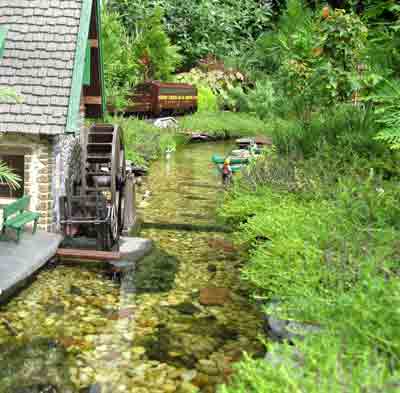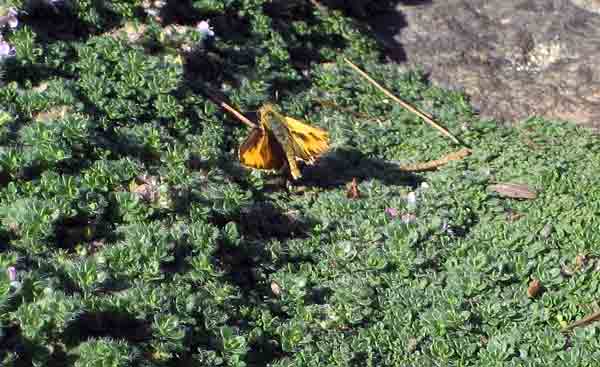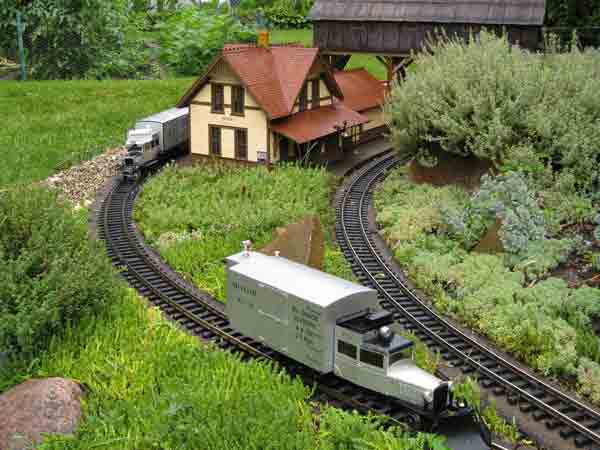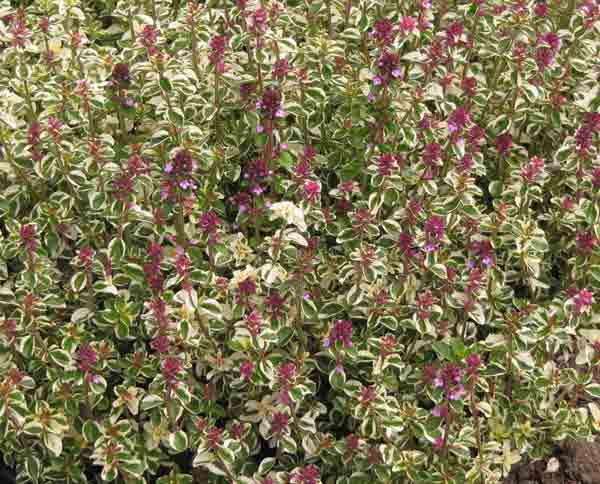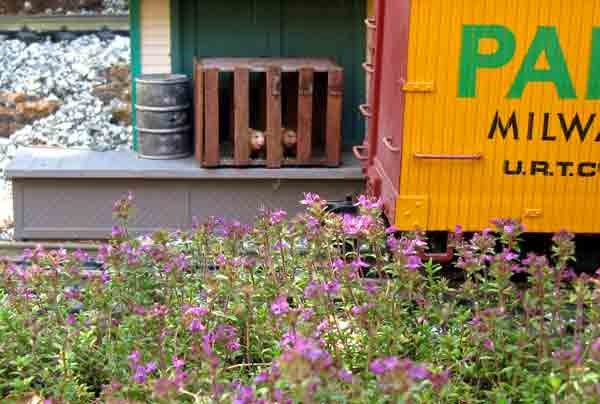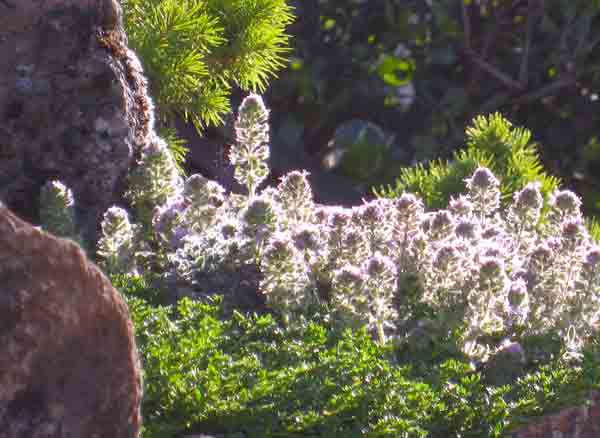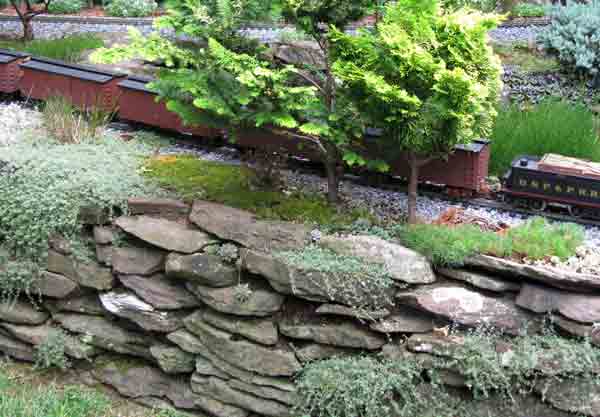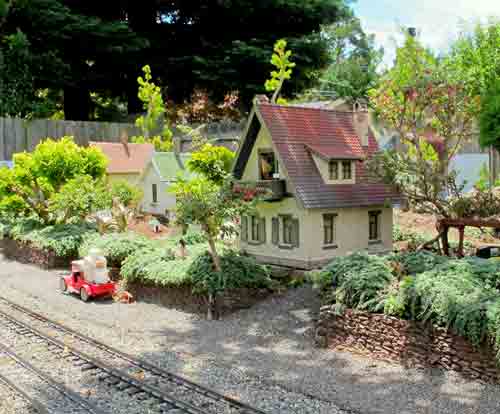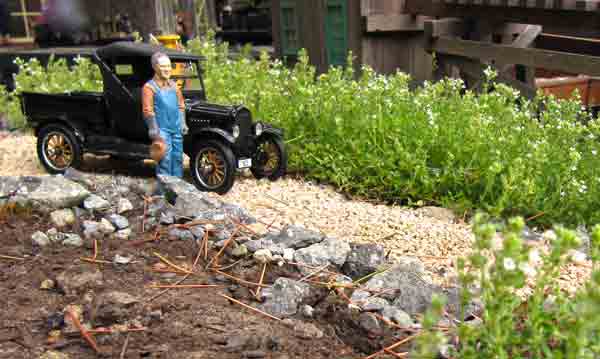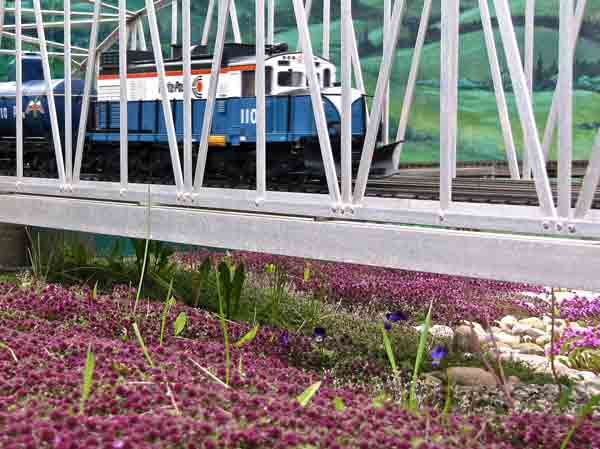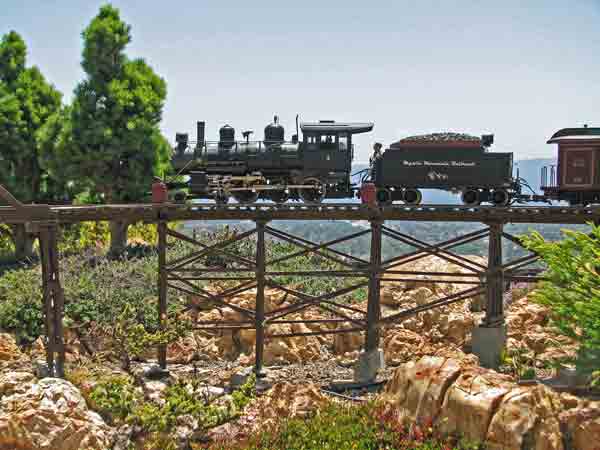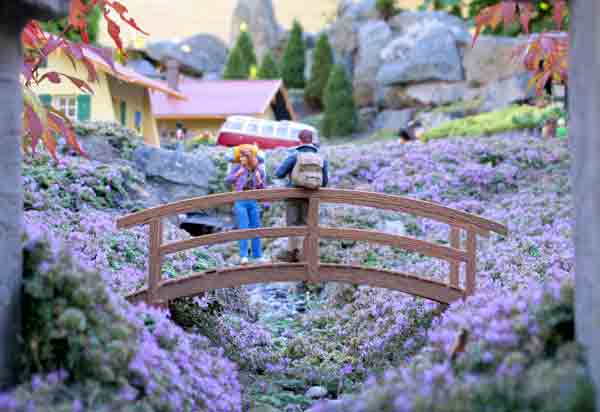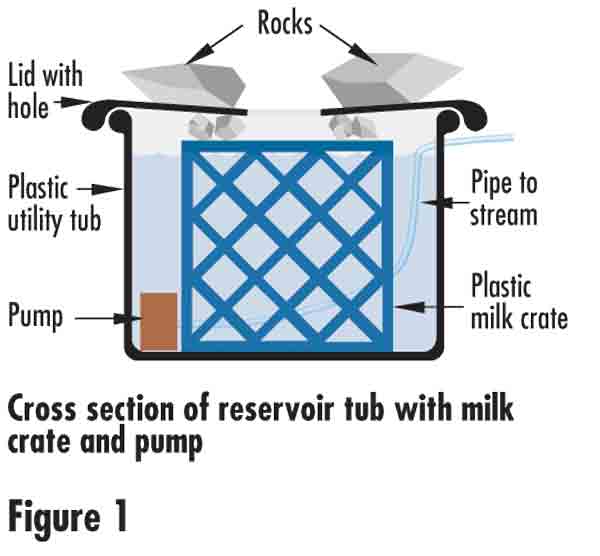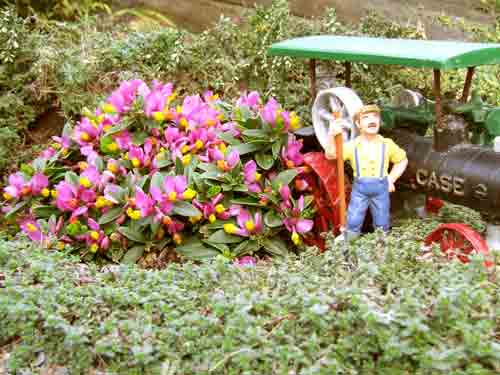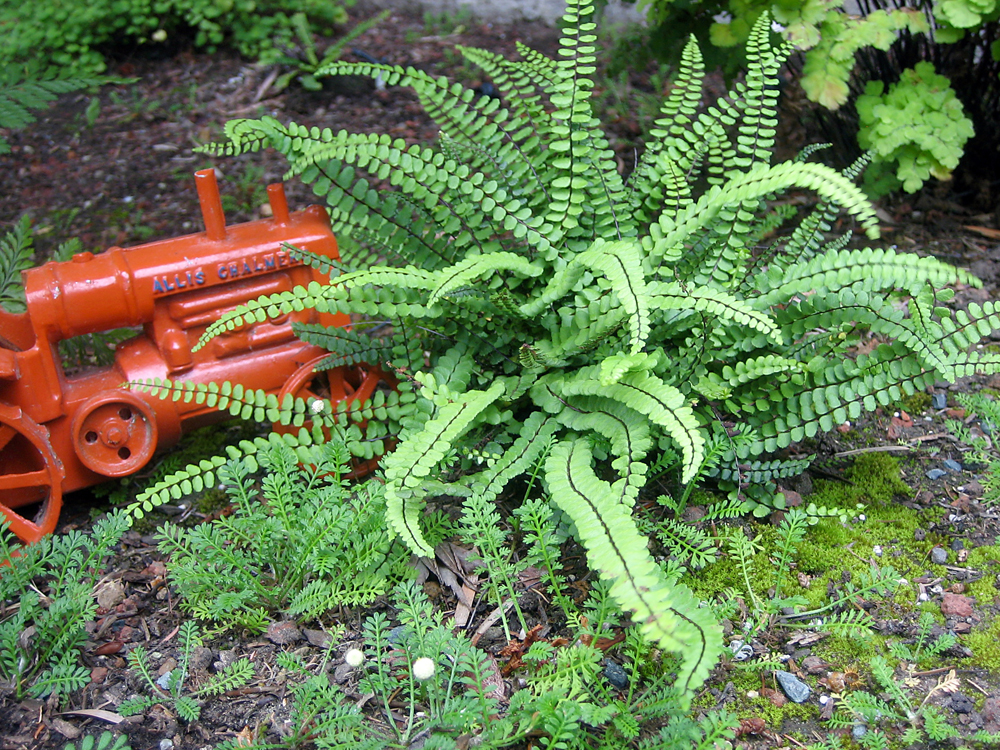Thyme is on your side if the miniature-garden look is what you want. Leathery, evergreen, and sometimes hairy, thyme’s fragrant leaves take the heat, love the sun, and withstand the abuse we often dish out while maintaining our railroad gardens. And the herb is good in food, too. Outdoor railroaders in Zones 3-11 know that thyme is of the essence in creating flat meadows, low groundcover between trees, thickets of shrubby trees, as well as embankments for streams (photo 1).
Finding thyme
All thymes of the genus Thymus grow as perennials, either creeping or bushy. How horizontal or how shrubby they grow depends on both the species and the climate. (See the “Regional gardening reports.”) Photo 2 reveals a fact about creeping thyme within a pathway—it’s only a matter of thyme before it’s compressed under foot—so if your thyme isn’t low enough, walk on it. Photo 3 compares two thymes, one as a thicket, one as a field. When purchasing plants, look for the stated height.
Showthyme
For ornamental value, more than 100 varieties of thyme take either a supporting role or steal the show. Some foliage glows with golden or white variegation (photo 4). Some turns reddish in winter. Others display seasonal trackside wildflowers that barely hide the wheels of your trains (photo 5). When 2″ starts are planted in a pile of boulders, thyme flies from crevice to crag for a classic alpine look (photo 6). Plant your little starts 6″ on center for quick coverage.
Two stone walls illustrate thyme’s versatility. First, woolly thyme fills gaps between natural stones in a 1:1 retaining wall (photo 7). Then, in photo 8’s 1:24-scale railway, Elfin thyme arches above a scale retaining wall, like juniper in a full-scale garden. Elfin grows slowly; trimming the stems so they won’t obscure the little stone walls is no problem.
Sands of thyme
Gravel or sand incorporated into your planting bed (photo 9) will give necessary aeration so the roots won’t rot. If your soil is heavy clay, remove half of the soil where the thyme will grow and incorporate sand, gravel, lava rock, or other drainage material, plus some humus. Thyme hails from the Mediterranean, a sparsely forested, hilly region that gets little summer rain. To simulate its preferred home and keep it healthy, plant thyme in sunny ground. When tree branches grow over and shadow that bed, plant a shade-loving groundcover (native moss, baby tears, or Irish moss) in the less-lit section and let them blend as they will. By now, after enduring dozens of puns, you should have an easy thyme pronouncing this herb.
These nurseries offer information on a range of thyme varieties
Mountain Valley Growers
https://www.mountainvalleygrowers.com/Thyme.htm
(19 groundcovers and 10 culinary thymes)
Portland Nursery
http://portlandnursery.com/docs/veggies/thyme-table.pdf
(thyme table of 28 ornamental and culinary thymes, mostly shrubby)
Stepables
http://www.stepables.com/scripts/prodList-plants.asp?idCategory=28
(11 thymes, mostly low groundcovers, with photos)
Joan Scheiwiller
Nanton, Alberta, Canada, Zone 3
Better luck next thyme
I sure had to chuckle, seeing this photo of our red-creeping-thyme field—and the start of all those dandelions and the grass growing up and in between! It was 18 years ago that I transplanted that bunch of mother-of-thyme from a garden in Calgary. Knowing the date of this photo, I was shocked to remember that I had been fighting this weed patch over five years. Procrastination is the thief of thyme.
Now I’ve dug up all the thyme plants (carefully separating them from weeds) and replanted them elsewhere as a carpet—I hope without broken grass roots, which act like seeds. Then I will re-dig the old beds for two years to make sure no grass comes up before planting anything. You can believe that I will be death on every blade of grass, digging it out until I see all the roots!
Dan Saporito
Long Island, New York, Zone 7
High thyme to mow the lawn
Thyme has been so easy to grow—no special needs, just average soil. It does well with the automatic sprinklers, spreading slowly during the growing season. I use bluestone dust over weed block for my roads, and the thyme spreads, puts down roots, and grows in that too. I only trim what overgrows the road area and over the tracks. As far as a lawn, it grows low and can be easily trimmed if I want a manicured look. My thyme varieties are easy to keep trimmed with pruning scissors and they spread 12-18″ in full sun. Jeepers Creepers is the brand name.
Richard Friedman
Sacramento, California, Zone 9
Killing thyme
I’ve had no luck with thyme. I know they grow here, as others have an easy thyme raising them. Me? Not so much. I don’t think they like my heavy adobe-clay soil. In the winter, it’s a sticky mud; in the summer, it’s a brick! I’ve tried planting it in small hills to improve drainage. That seems to work for a while but in the end I just run out of patience and thyme.
Ray Turner
San Jose, California, Zone 9
Right place, right thyme
I have planted thyme extensively—because it seems the most survivable groundcover that spreads reasonably, is easily pruned around track, and doesn’t spread out of control like Bolaz globaria or Herniaria ‘Green Carpet’. My soil is a mix of planter mix and California clay, watered by automatic drip. Some is in full sun and some is in partial shade. Sunny areas will grow faster but require more water. Don’t let the soil completely dry out—incorporate humus. Very little fertilizer (I use Miracle-Gro) in the spring goes a long way.
Elfin thyme spreads slowly in a tight mound, low to the ground. In the spring it blooms profusely with tiny purple flowers. Lemon thyme is less dense, and taller, appearing somewhat rangy (it’s also good for cooking). It has yellow/green leaves and I like it where the additional height goes against a cliff. Woolly thyme is of medium height and density, with a carpet of purple or purple/white flowers in the spring. It spreads readily but is easy to control by pruning around track and structures.
Keith Yundt
Victoria, B.C., Canada, Zone 6b
Never enough thyme
These groundcovers stand the test of thyme here because the deer don’t eat them—a good thing, considering the deer polish off just about everything else around our place! One glance at our railway and you’ll see many thymus varieties, each with its own unique characteristics.
Woolly thyme (T. pseudolanuginosis) has a mild smell, quick growth, and good coverage for embankments but may get “leggy” if watered too much, and will tighten right down when dry. We’ve seen no sign of damage from snow or frost, and this species seems quite happy growing in shady areas. Due to its relatively “open” or less densely leaved nature, other plants can get in and cause troubles (see Joan Scheiwiller’s report).
Lemon thyme (T. citriodorus) has a strong smell, especially when rubbed. Relatively quick growing and good for covering embankments, it tends to grow with thicker stems that make it less like a groundcover and more like a little bush. It seems to need sunlight the most, and does not like being shaded by other plants. It has died back from snow/frost damage but always recovers.
Doone Valley thyme (T. citriodorus ‘Doone Valley’) has a very mild smell. It’s slow growing and can get quite “open” when older. One thing I have noticed that it does not like, is competition from stonecrop (Sedum sp). Keep it in good light.
Elfin thyme (T. serpyllum ‘Elfin’), is my favorite! Once it gets established, it is hard for any other plants (like weeds or sedums) to get a foothold. It’s hard not to love it and think that it was meant for garden railways. One winter we had some extended, snowy, cold weather and it suffered quite a bit of die-back but slowly recovered.





